Well that didn’t take long. It’s only our second move in this crazy Army life and it happened. We had a nightmarish moving experience. Among a laundry list of other things that went wrong, our movers broke our dining table. When putting it back together, they tightened one of the bolts so tight that they sent it straight through the top of the table! Is it bad that my first thought was, “meh. I could build a new one.” I mean, yeah, the easy solution would have been to just repair the damaged spot and refinish the table, but who wants easy? Pfffft. Besides, I was just waiting for the perfect excuse to start another DIY project, much to my husband’s chagrin.
Just kidding, Honey, you’re super supportive and I love you (just in case he reads this blog).
So I went window shopping for some dining table inspiration and ran across this beauty from ZGallerie:

Yep. She’s pretty hefty, right? And she costs $1299. Womp womp. If I spent a thousand bucks on a table, my husband would kill me (we ain’t fancy peoples, y’all). I mean, I totally understand spending that kind of money on furniture, but not my husband. Nope. He’s the kind of guy who wonders why we need curtains when we have blinds.
Sadly, I can’t just look at a piece of furniture and figure out how to build it. That’s where my friend, Ana White, comes in. She’s a genius at doing just that. So we put our heads together and came up with a plan to make…
This! And guess how much the lumber was. Are you ready for this? $85. Yep. That’s eighty-five bucks. What the duck?!
DOWNLOAD THE FREE BUILDING PLANS HERE.
TOOLS:
- Tape Measure
- Speed Square
- Pencil
- Pocket Hole Jig
- Drill
- Miter Saw
- Table Saw
- Brad Nailer
- Sander
- Drill Bit Set
MATERIALS:
- (9) 2 x 6 x 8 Ft. Boards
- (9) 2 x 4 x 8 Ft. Boards
- (1) 1 x 4 x 8 Ft. Boards
- 2 1/2-inch Pocket Hole Screws
- 2 1/2-inch Wood Screws
- Wood Glue
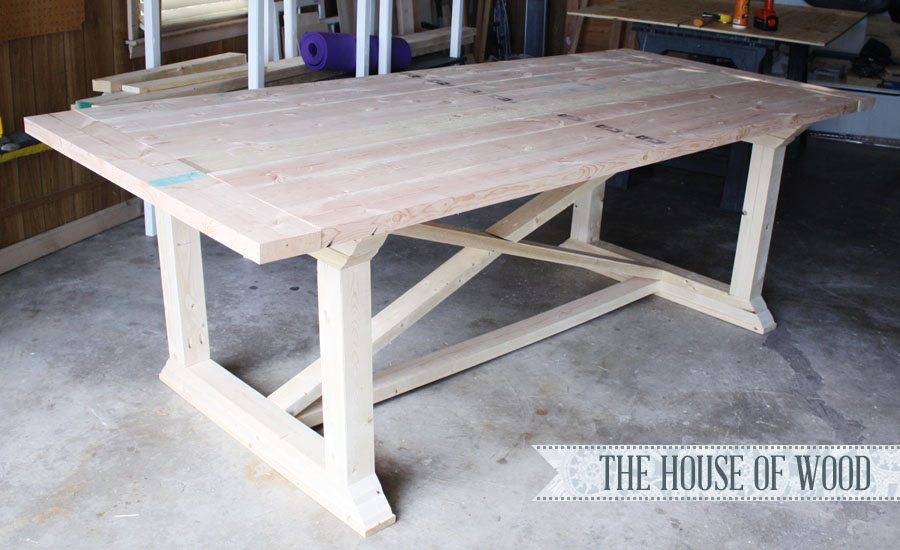
Building with 2x6s and 2x4s was definitely a workout. I needed my husband’s muscle on more than one occasion to help me manage this behemoth while building. First, Ana recommended running the boards through a table saw to square up the edges. The tabletop is planked, and while I do like ‘rustic,’ I still wanted ‘refined,’ so I shaved less than 1/4″ off each edge so that I could work with perfectly square, straight edges. Ana’s brilliant idea satisfied the perfectionist in me, being that each board sat flush to the next. I like it when wood plays nice. (Hey now! This is a family blog!)
Here’s the tabletop, all screwed and glued together. Those are 2×6 boards. Pretty stout!
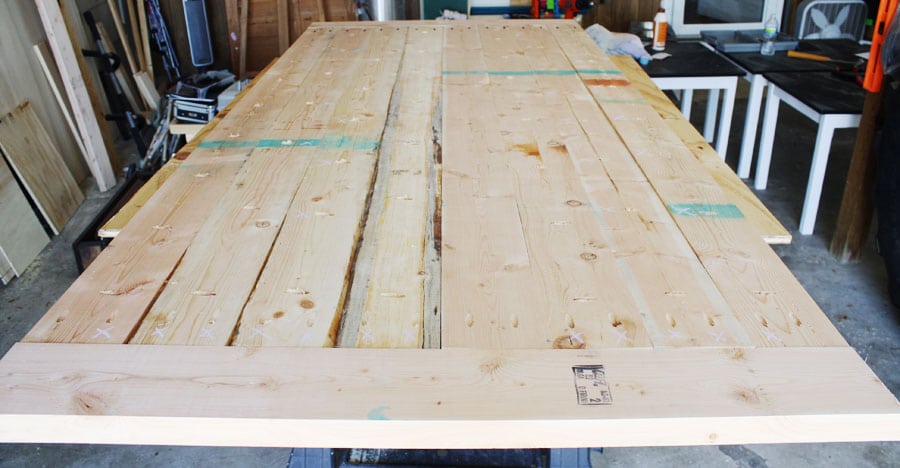
Then I cut two different angles on my 2×4 supports. The first angle is at 30 degrees, and the second one is at 45 degrees off square. It made for a pretty beveled detail, much like the ZGallerie table. Ana is so detail-oriented when it comes to sketching up plans; she amazes me.
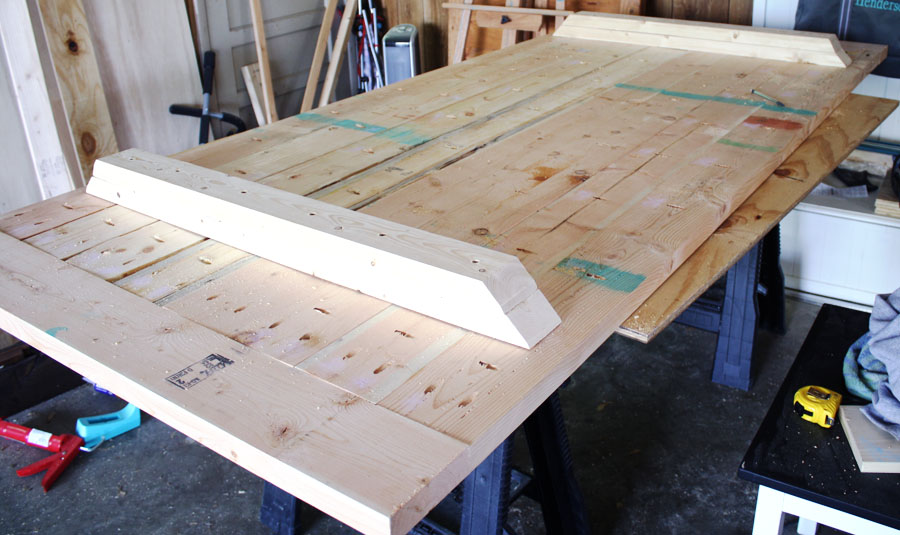
Then I built the legs out of 2x4s. You know how 2x4s are slightly rounded on the edges? Because I shaved off the edges, they’re nice and square, giving it the illusion of a solid leg. I think this also helps make framing lumber look more like finish-grade lumber. Fake it till you make it, I guess?
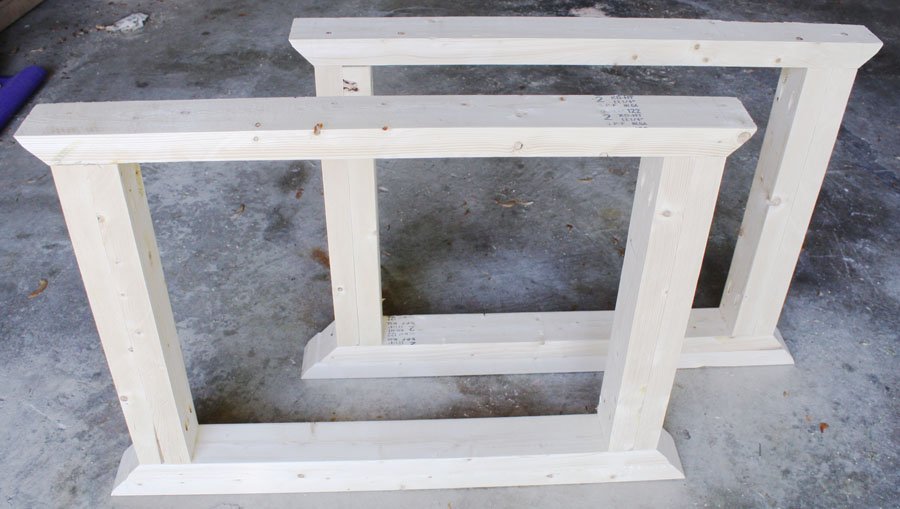
Then I added the stretcher bar. The base is flipped over so I could hide the pocket holes underneath when attaching the stretcher.
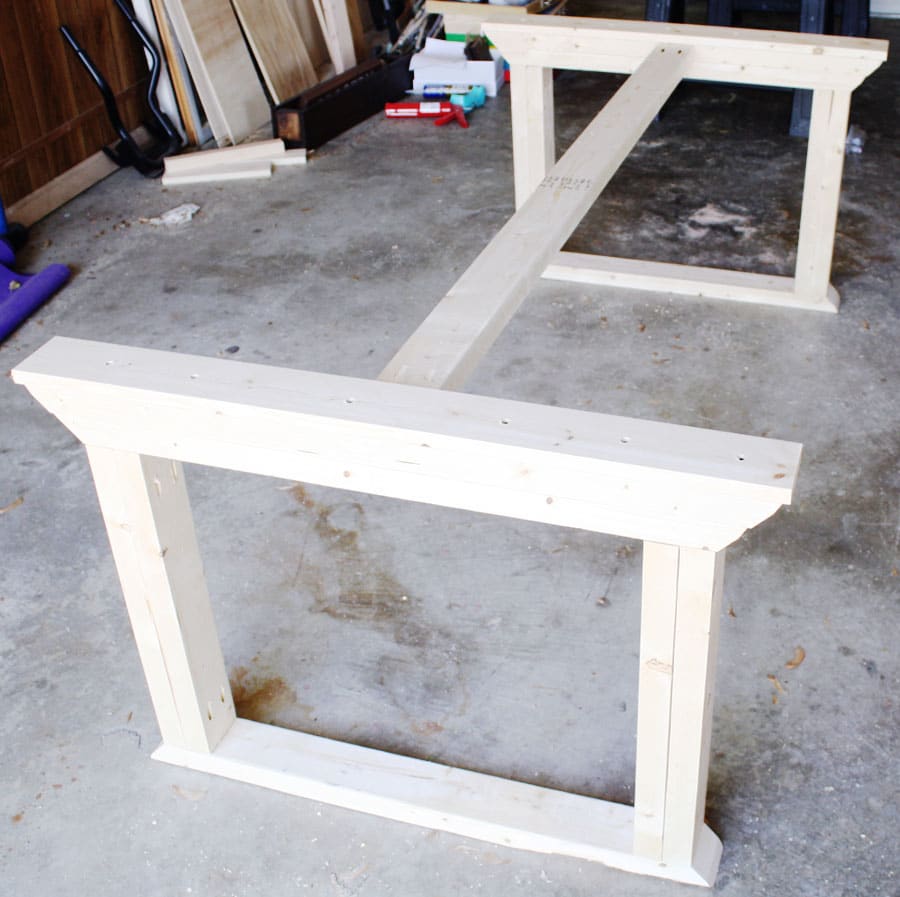
And here’s the tricky part: adding the X to the legs. The outside angles of the X are at 20 degrees off square and the middle of the X are 50 degrees off square (as noted in the plans). I made sure to measure and mark where the middle was so that everything looked balanced and even.
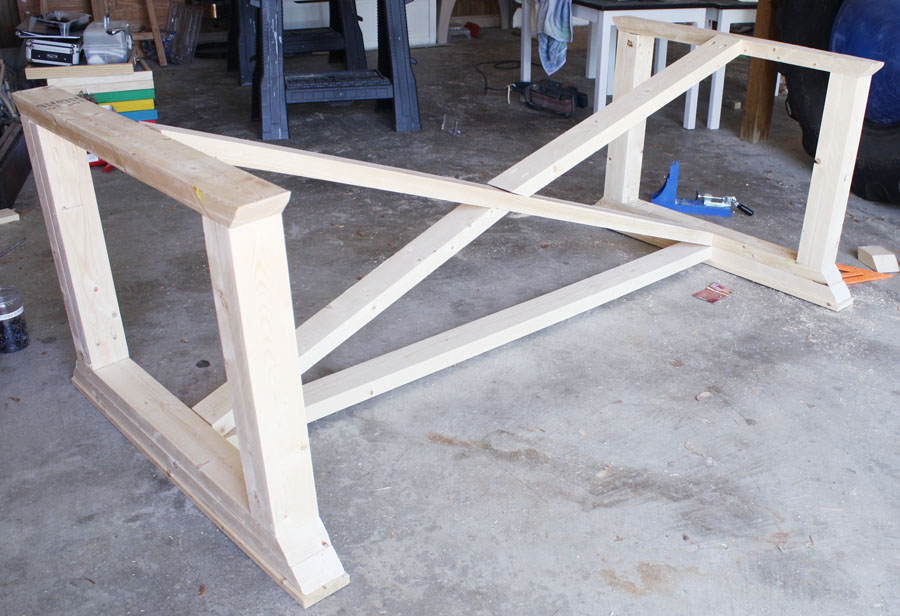
And we’re done!
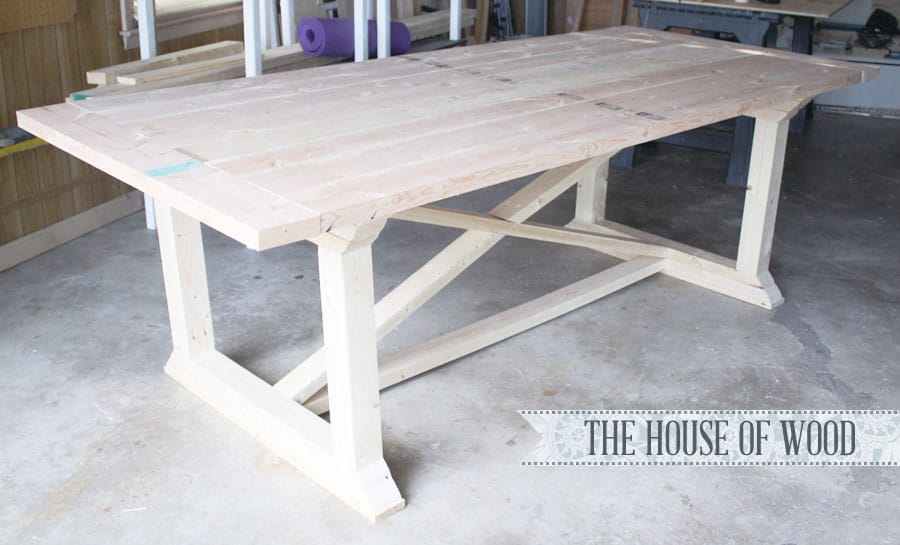
I didn’t attach the tabletop to the base just yet (I just laid it on top for the photo op) because I’m going to sand and stain the two parts separately. Then I’ll bring them into the house to assemble because the table won’t fit through the door fully built. Also, since we’ll be moving again in the next couple years, I’ll attach the top to the base with bolts (instead of screws and glue) so that it can easily be disassembled when moving day rolls around. Hopefully by then, we’ll have more careful movers (yeah, right).
I’ll be back with a finishing tutorial as soon as possible! In the meantime, you can build your own ZGallerie-inspired dining table with Ana’s plans! Thank you, Ana! It turned out beautifully!
How about you guys? Care to share any moving day misadventures? Does anyone else (who is not in the military) move around as much as we do? Thanks for reading, see y’all soon!
Update: Here’s the link for the Restoration Hardware-inspired finishing tutorial.
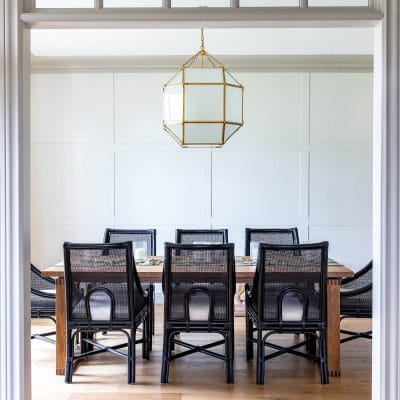

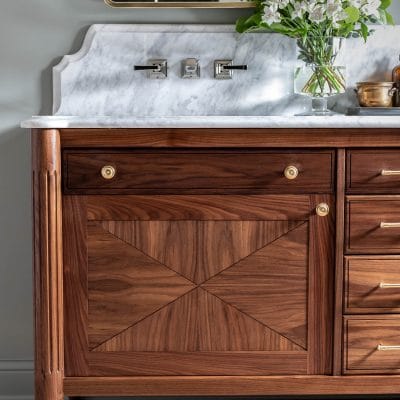
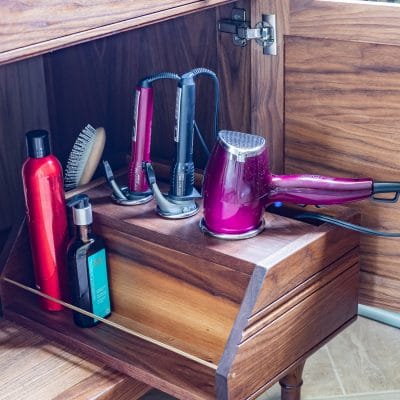


Hi, thanks so much for this awesome tutorial. I’ve made the table, and I can’t wait to try the finishing technique you posted about – stunning! I just have a question about the top. I want to be able to remove the top from the legs (it won’t fit through my small doors). Did you use a special kind of screw so that it can be removed and put back on without damaging it? Thanks again!
Yes, I used the bolts from my existing dining table and used threaded inserts so that the bolts are screwing metal into metal (so no worries that the wood will strip over time). Hope that helps!
Thanks!
We just started making this table and wondered if you had any tips for getting the table boards level/flush so that the top is smooth? Or did you have to sand it smooth?
You definitely want to work with the straightest boards possible. I’m really picky and will spend hours sorting through the lumber pile to find the best boards. Also, be sure to work on a flat surface. My garage floor isn’t flat or level, so I had to put a piece of thick plywood down as a base, so I could work from a flat, level surface. If you have a planer, I’d recommend running the boards through your planer so they’re all the same thickness. This will help get each of your tabletop planks flat and even. Use clamps and force the boards level/straight when you’re gluing and screwing them together. Hope that helps… good luck!
What kind of wood did you use to build the “x” table?
Douglas fir and pine
I’m not finding the finish tutorial. Can someone please direct me?
Thank you!!
Beth
Hi Beth!
The link is here: https://jenwoodhouse.com/2013/08/07/diy-dining-table-achieving-rh-finish/
Thank you!!!
How many 2×4 and 2×6 at what length did you use
I can’t remember off-hand, but it’s all in the plans!
Hi, I have a very basic question about the top of the table. I see you used pocket hole screws to attach the shorter end pieces to the longer boards. How did you attach the longer boards to each other? Just wood glue or some sort of screw as well? Thanks!
-Matt
Hi Matt!
I used pocket hole/pocket hole screws to attach the boards together, side by side.
This turned out *so* beautifully! I’m trying your finish on a console table (the first thing I’ve made – I’m brand new to this), and I’m wondering about the whitewashing step. Can you be more specific about the white paint that worked for you and the waiting time after that step and before the mixed-stain step? And then after that last stain before the urethane step, did you let it dry overnight? And finally, how long did you wait between the urethane coats? Thanks!
I love this table! You inspired me to make our own.
Yay! Happy building!
Is putting the X on the table required? Or would I be able to skip that step? Thank you!!
Using pocket screws to install the breadboard…
Do you not have to worry about seasonal shrinkage with 2x members? Seems like you wouldn’t want to constrain your table top in such a way… but perhaps splitting is only a problem with 1x members.
You’ve had your table almost 2 years now… any splitting or other issues ??
Thanks
We haven’t had any issues thus far, but adding extra supports underneath the breadboard to support them (in case rambunctious children want to climb up and sit on the breadboards) would be wise.
Hi Jen! I see this post is over two years now, but I have a couple questions. Have you had any support issues with the breadboard ends and them being attached with pocket holes? I was about to build this table and I showed some experienced furniture builders and they told me pocket holes are a definite no-no for the breadboards. One argued biscuits and the other said nothing but mortise & tenon. I feel biscuits are like pocket screws and I’m not good enough for mortise & tenon, but I love pocket screws, so I wondered if after two years, you had any issues with people leaning on the ends. Also, I can’t stop finding all this stuff about tabletop movement. You have any issues with that or warping? I want to build this so bad. Thanks so much!
Hi Joe! I haven’t had any issues with the breadboards, but you’re right. It may be an issue in years to come. I can just see my kids sitting on the ends and the breadboards snapping right off. I was planning to attach a couple of support boards underneath, just to give the breadboards more support. Like I said, it hasn’t been an issue thus far, but I do plan on attaching those supports, just in case.
Has it lasted two years even with “elbow leaners” sitting at the ends? That’s really all I care about. All these sites talking about wood movement and not using pocket screws annoys me because I was so excited to follow your plans and get ‘er done. You’re saying, you’ve had no issues. Looks like a green light for me to continue on building it.
We never had any issues, but to be honest, we only used the dining table on special occasions. We eat in the eat-in-kitchen on the daily. I’d still recommend adding those supports, if you can. Happy building!
Update 1/12/2016: Here’s a helpful video on how to attach breadboard ends: https://www.youtube.com/watch?v=EnghqwOrsbw. Hope that helps – good luck!
Hi Joe,
I am thinking of building this table and had similar questions, as i have seen similar posts about warping and breadboard ends. Did you ever build it and if so how has it been for you. I have no woodworking experience and am just getting into it!
Thanks!
Hi Jen –
After you ragged on the white paint, you mentioned you mixed another Special Walnut with Weathered Oak. Did you actually mix the two or did you apply them on top of each other as you did for coats 1 and 2? If it’s the former, what ratio did you mix the two stains together?
John, I applied the two stains separately, one on top of the other. I did not mix them.
Hey Jen! I hope you see this SOON lol..My husband and father in law are literally right beside me in our garage beginning to build the table!! We were wondering how far back from the edge of the plank did you place your Kreg Jig?? I hope this question makes sense…as you can see- we are new at this…Pray for us LOL
Yay for building! If I’m understanding your question correctly, I put my boards flush to one side of the Kreg Jig and drill in the “B” hole, so the pocket hole is just a few inches from the edge of the board. Good luck!
Hey Jen, I love the table and restoration hardware finish! I was wondering if the stain was allowed to dry before adding the white wash?
Thanks so much! Yes, the stain fully cured before I applied the white wash.